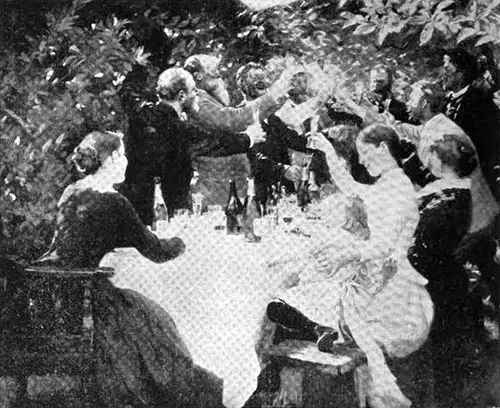Danish Family Dinners - 1905

In an article contributed to the 1905 Church Family Newspaper, by A. Skovgaard-Pedersen, on Danish customs, we learn that in Danish family’s dinner is eaten about twelve, and a peculiarity of Danish dinners is that they generally begin with a course of what is called " spoon food."
This may consist of a kind of porridge—not made with oatmeal, but with barley or Boghvede, a kind of grain not grown in this country—but more often a sweet soup is served. There is a great variety of these, fruit soups being the most common.
A really delicious kind is made by boiling sago in water flavored with the juice of raspberries or some other fruit, to which prunes, raisins, and pieces of apple are added, the whole is allowed to simmer for some time until all the fruit is quite soft. Meat soups generally contain dumplings of some description; pea soup is served with whole peas in it.
The next course is usually meat, though fish or poultry may take the place of it. The meat is cut up before being brought to the table, and each person helps himself with his own fork.
Fruit compotes and vegetables are eaten with the meat. Puddings such as they have in England are almost unknown in Denmark, but in the summer a fruit dish is often partaken of as dessert.
The great national dish is rod grod, which is made as, follows: Stew about a pound of red currants and sweeten to taste. Strain these and pour a pint of the juice into a mold.
Dissolve in this half an ounce of gelatin or a little more in very hot weather and leave it to set. Serve with good milk cream or thin custard. A similar dish can be made with gooseberries or almost any fruit, and it is an ideal summer sweet.
Another, which to English readers may sound a little less palatable, is known as "thick milk." Set some very rich milk aside for two or three days until it has become quite sour, and also of the consistency of jelly.
Into this crumble rye-bread—if preferred, cake —and add plenty of sugar. It is really, as the Philistine said of Wagner's music, much nicer than it sounds, and to Irish people at least it will not be entirely unfamiliar.
Beer, either alcoholic or otherwise, is drunk at dinner, and coffee follows. Tea is usually taken between five and six. It is a beverage which is not understood in Denmark, though the coffee approaches perfection.
If visitors are present, a tasty dish of meat or poultry is frequently served; otherwise, the staple dish is smorrebrod— slices of bread-and-butter, on which are spread a layer of cheese, hard-boiled egg, and anchovies, sardines, sausage, smoked ham, or smoked salmon.
On special occasions chocolate, accompanied by a sponge or some other rather plain cake is served first, and then coffee, with rich cakes, full of cream.
Scandinavians have strong digestions as a rule. Supper is a very light meal, consisting of tea, bread-and-butter, or biscuits, with perhaps cheese or fruit.
Table Observance in Danish Families
What strikes me as being a pretty table observance in Danish families is for children, even little ones, who can scarcely toddle, to go gravely after dinner to salute their parents and say Tak for mad (thanks for the meal). Even visitors shake hands with their host and hostess and go through the same formality.
Custom, however, probably stales these observances, and it may even be that the practice in our own "genteel" circles of speeding the parting guest by saying, "Thank you for your company," and of responding with "Granted," when you "beg pardon" for treading on their toes in a 'bus may appear graceful forms of expression to some foreign critics of our ways.
"Danish Dinners," in The Epicure: A Journal of Taste, Vol. XII, No. 141, August 1905, p. 277+, 210
